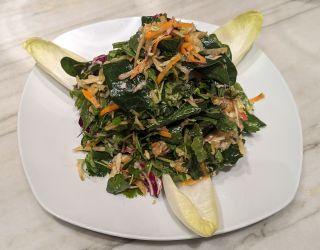Time Management
The Multi-task of Balancing Time and Sharing Time
This Fall Greens Market Salad shows the way.
Posted October 11, 2023 Reviewed by Gary Drevitch
Key points
- One strategy in time management is to think about balancing time and sharing time.
- Some examples could be pumpkin picking, visiting a farmer’s market, or planning an academic schedule.
- A Fall Greens Market Salad incorporates seasonal ingredients and a tasty dressing with maple syrup.

We plan and plan for summer, anticipating those long, sunny days, and then, before we know it, it’s over. Vacation is done, kids are back at school, and we find ourselves in a fast-paced fall routine. Wasn’t it just Labor Day? What are all these Halloween decorations about?
The new business ushered in by fall can leave us racing: We pack school lunches, organize schedules, manage work, get chores done, pay bills, and show up for the many important activities our kids of all ages engage in: sports, drama, debate team, homework, college applications, and college parent weekend, to name a few.
There isn’t one answer for how to manage time but following are some ideas for making the space to balance our time and share it with loved ones. This post invites us to re-imagine the resource of time in our lives.
Time Management Strategies
Fight procrastination. Procrastination is a tough one. The more I put something off, the more it’s on my mind. I've recently realized that the awareness of the thing I still haven’t done probably takes more energy than actually doing it. And once I finally decide to address that thing, it gets done much more quickly than anticipated. It makes me wonder why I procrastinated in the first place.
We might procrastinate when we think a task is going to take longer and be more difficult than it actually is.
Make a list and plan your time. Ours is a multi-task world. Multiple responsibilities can be overwhelming and easily lost in our daily lives. Different strategies work for different people. Here’s one: I keep a notebook and write down all the tasks I can think of that need to be done at the start of each week. Even if the list is impossible to complete within that week, it's OK; I can prioritize which tasks will be due on certain days and move the others to the following week as needed. But once the tasks are on the list, I don’t have to worry about forgetting them.
Dedicate your time. On the one hand, we’re multi-taskers; on the other, there’s something to be said for dedicating our time. By that, I’m referring to the importance of focusing our energy so we can be truly present in the moment with someone. Recently I’ve been putting my phone away when seven-year-old Olliver has an activity like swimming or soccer to avoid distractions and focus on him. If Olliver looks over from his game or practice, I want him to see me watching the event, not looking at my phone. Of course, nothing’s perfect; there may be reasons to be on the phone, but intentionality is still leading this effort.
Make extra Fall Greens Market Salad. My chef husband Julian just made a big bowl of this salad. (See recipe, below.) It was wonderful to open the fridge and have it ready for a meal, freeing up time to engage in other activities. There are many ways we can do this with cooking. Today I’m adding grape tomatoes, olive oil, sautéed mushrooms, and parmesan cheese to the extra pasta prepared for Olliver’s school lunch.

Time Sharing Strategies
Go picking. Fall is a beautiful time of year to go picking with your loved ones. Whether it’s a pumpkin patch or an apple orchard, sharing time choosing items you plan to turn into a delicious creation is a wonderful way to bond. The activity of picking pumpkins, for example, is a built-in way to stay in the moment with loved ones rather than being on our devices.
Visit a local farmer’s market. Part of setting the table for connection (Clauss-Ehlers & Clauss-Ehlers, 2022) is to be intentional about time spent together. Visiting a farmer’s market is a balanced way to multi-task; we can spend time together while also grocery shopping. Sort through the stands in search of the hearty ingredients for our Fall Greens Market Salad.
Build an academic routine. This morning, as Olliver and I packed up his homework packet, we realized that he forgot to complete te second page. He quickly completed it over breakfast, and put it in his backpack to hand in. Our last-minute rush reminded me how useful it can be to have an academic routine. Is there a day, time, and place that can be the designated homework engagement moment? For kids applying to college, is there a dedicated time to focus on the application process? In a way, this in-the-moment dedication lends itself to having more sharing time later. If we focus on the work in that moment, hopefully we can relax and be more present afterward.
Time is a resource. For most of us, it’s a scarce resource. We feel stress when we don’t have enough resources to meet environmental demands. One strategy is to think about balancing time and sharing time. On the one hand, we try to balance time to get things done, but as we move away from trying to bring task equilibrium to our lives, we can share time with our loved ones.
Fall Greens Market Salad
Have fun with this fall salad made with seasonal ingredients found at your local farmer's market. This is a versatile recipe because you can swap out ingredients easily and create a delicious salad that incorporates your favorite bits. It also includes a delicious dressing you can use on any salad you make.
For 4 people (Main course)

Salad Ingredients
1 Belgian endive
1 small head of radicchio (torn apart)
2 oz baby arugula
1/2 bunch watercress (washed and dried)
3 oz baby spinach leaves (washed, leaves torn apart)
1 oz fresh parsley leaves (washed and dried)
1 small carrot (peeled)
1 small celery root (approx 4oz) (peeled)
2 oz fresh mushroom (shiitake, cremini)
1 large apple
4 large radishes
4-6 Brussels sprouts
Salad Dressing Ingredients
2 tablespoons Dijon mustard
3 tablespoons balsamic vinegar
1-1/2 tablespoon maple syrup
1/2 cup extra virgin olive oil
Kosher salt and freshly ground black pepper to taste
Directions
For the salad. In a large bowl, place the arugula, watercress, spinach, parsley leaves, and shredded radicchio.
With the box grater, use the large grate side and grate the carrots, then the celery root, the apple, the radishes, and finally the Brussels sprouts into the bowl. Next, slice the mushrooms with a knife and add them, too.
For the dressing. Place all the dressing ingredients into a small jar with a tight-fitting lid. Secure the lid and vigorously shake the jar to mix the ingredients.

Put it all together. To finish your salad, pull apart the endive leaves and place points (like a clock hand) at 12, 4, and 8 o’clock, around four plates.
Place any extra endive into the large bowl. Lightly mix the salad. Then drizzle the dressing all over. Again lightly mix and then divide the mixed salad into the center of the four plates.
Serve and exhale.
References
Clauss-Ehlers, J.C.E., & Clauss-Ehlers, C.S. (2022). Eating together, being together: Recipes, activities, and advice from a chef dad and psychologist mom. Princeton Architectural Press.




